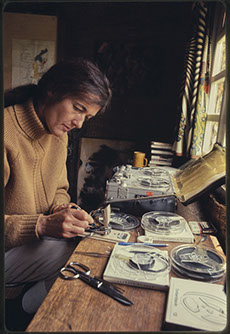


Fossey’s Gorilla Research: At Camp and in the Field
During her early years at Karisoke, Fossey worked tirelessly in extremely difficult field conditions to document countless aspects of gorilla behavior and biology. In 1969, she rescued infants Coco and Pucker from near death. Orphaned in separate efforts to capture specimens, nursing them back to health at Karisoke helped her to understand behaviors, such as vocalization, that she could not observe in gorilla groups unaccustomed to her presence. With improved knowledge of gorilla behavior, Fossey later succeeded in habituating wild gorilla groups to human company, allowing her to collect better data. Fossey collected audio recordings, skeletal materials, and conducted field observations to document the lives of gorillas she researched.
Simply maintaining the camp required great efforts by many individuals, adequate funding, and constant management. Karisoke was isolated from nearby communities, so supplies had to be carried up the mountain on foot. There was no electricity or running water. Researchers lived in tents until Fossey eventually built small cabins for herself and her team.



Bob Campbell (British Kenyan resident, 1930-2014)
(top row) Dian Fossey editing audiotape recordings, Rwanda. 1969.
(middle row) Dian Fossey with orphaned gorillas Coco and Pucker, Rwanda. 1969; Dian Fossey at field site sitting in rain, Rwanda. 1970.
(bottom row) Dian Fossey sitting on a bench in front of wood fire with kettles, Rwanda.
1971; Dian Fossey in the window of her cabin. 1969.